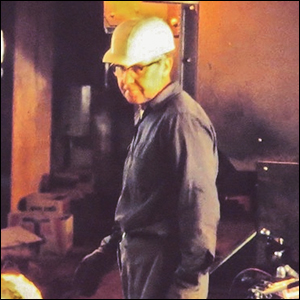| In Memoriam: Ray Tunquist August 25, 1917 — November 7, 2010 |
|
| A man of great importance to the art of guitar making passed away six years ago at the age of ninety-three. Raymond Elwood Tunquist of New York was a sawyer of excellence, a WWII pilot, and wonderful gentleman. Perfection of cut was his mission. For over fifty years he cut guitar-making materials of Brazilian and Indian rosewood, mahogany, and ebony for C.F. Martin, Fender, Gibson, and other makers. If you have a Martin from the 1940s, ’50s, ’60s, or ’70s, chances are Ray and his 72"-diameter bulbous-back veneer saw cut the wood. The mill yard often had stacks of rosewood and mahogany logs of great size and quality waiting to be cut by the master of sawyers. Doll Lumber and Veneer was started by Ray’s father-in-law. Mr. Doll was a German immigrant who lived in Brooklyn, New York, with his family. He started the saw mill in Brooklyn in the 1920s. Exotic wood logs came into the USA from all around the world and were cut by Mr. Doll into lumber and veneers. Ray married into the family and learned his craft in the late 1930s. Clients were log buyers and importers and Doll was known for quality of cut and better-than-average yield. J.H. Montheath, Albert Constantine, and Martin Guitar were on the client list. Two saws were used in the mill: a 60" bandsaw and the 72" circular saw, each using a carriage-and-rail system to carry the logs to be cut. The big saw had sixteen fine-tooth blade sections attached to the back so that the face was dead flat. It was powered by a 150 hp diesel engine and could cut 1/16" × 16" veneers 12' long. Ray had a pilot’s license, and when he was called to service in 1942 he became a flying instructor at Brooklyn’s Floyd Bennet field for about eighteen months. Then in 1944 he was assigned to transport aircraft manufactured on the East Coast to the west. He was qualified to fly Hellcats, Bearcats, Corsairs, and other aircraft. Altogether his service lasted over four years. Back to work at the mill, Ray cut thousands of logs of all species: teak, mahoganies, rosewoods, zebrawood, ebony, lignum vitae, oaks, pines, poplar, and more. The quartersawn white oak in the Frank Lloyd Wright Room at New York’s Metropolitan Museum of Art was cut and dried by Ray. Brazilian rosewood logs were purchased by the mill to be resawn and sold to Martin and other guitar makers. The bulbous-back veneer saw would produce flitches of veneers 5/32" thick, 5"–11" wide and 8'–10' long. Those swirl patterns you see inside old Martins tell you it came off the big circular saw. In the late 1940s the mill was moved to upstate New York for more mill space and a rural lifestyle. A kiln was also built to dry the lumber. After the 1966 Brazilian log embargo, Indian rosewood was processed. Most Indian logs were 8'–10' long and were 30" or more in diameter, ranging up to about 46". The largest log cut at Doll that I saw was mahogany, 40" long by 64" diameter. We cut the log into 10' lengths, scored the center of one end with a chainsaw, and spilt it using a giant forklift. Thousands of quartered sets came out of this log. I still have a small flitch of twenty or so sheets, 14" wide and 10' long. The sawn guitar wood was stickered for air drying. When it was dry it was restacked into flitches and shipped. The Doll and Tunquist families were most likely the only families in the country to heat their homes with rosewood and other exotic wood waste! They were thrifty old timers. Ray was a great, wonderful, very smart man who worked at the mill until the age of ninety-one. He was short on words and opinion, but a true craftsman and teacher. May Ray rest in peace and may the music produced by his wood-cutting efforts sound sweetly to all. |
Top of Page |

